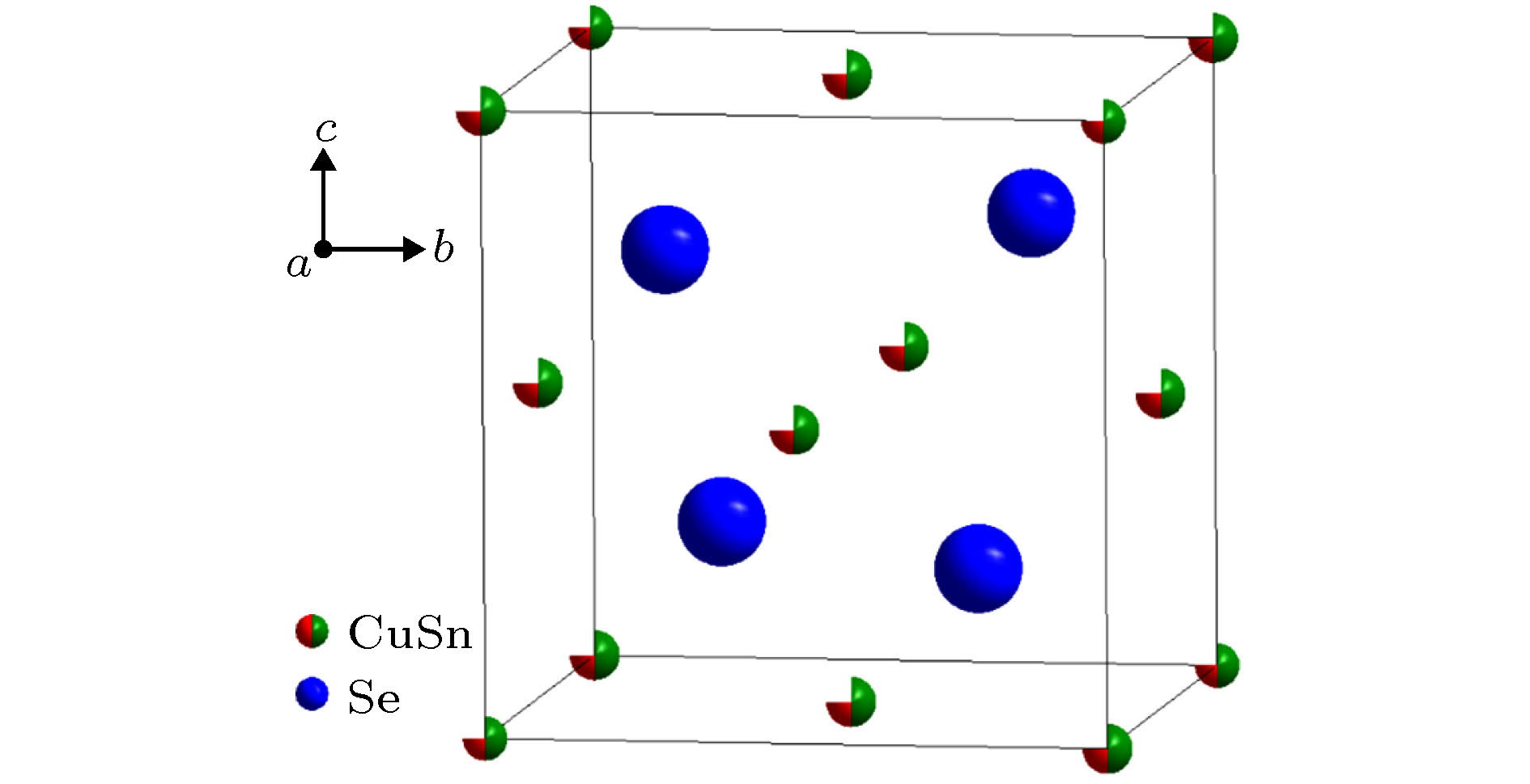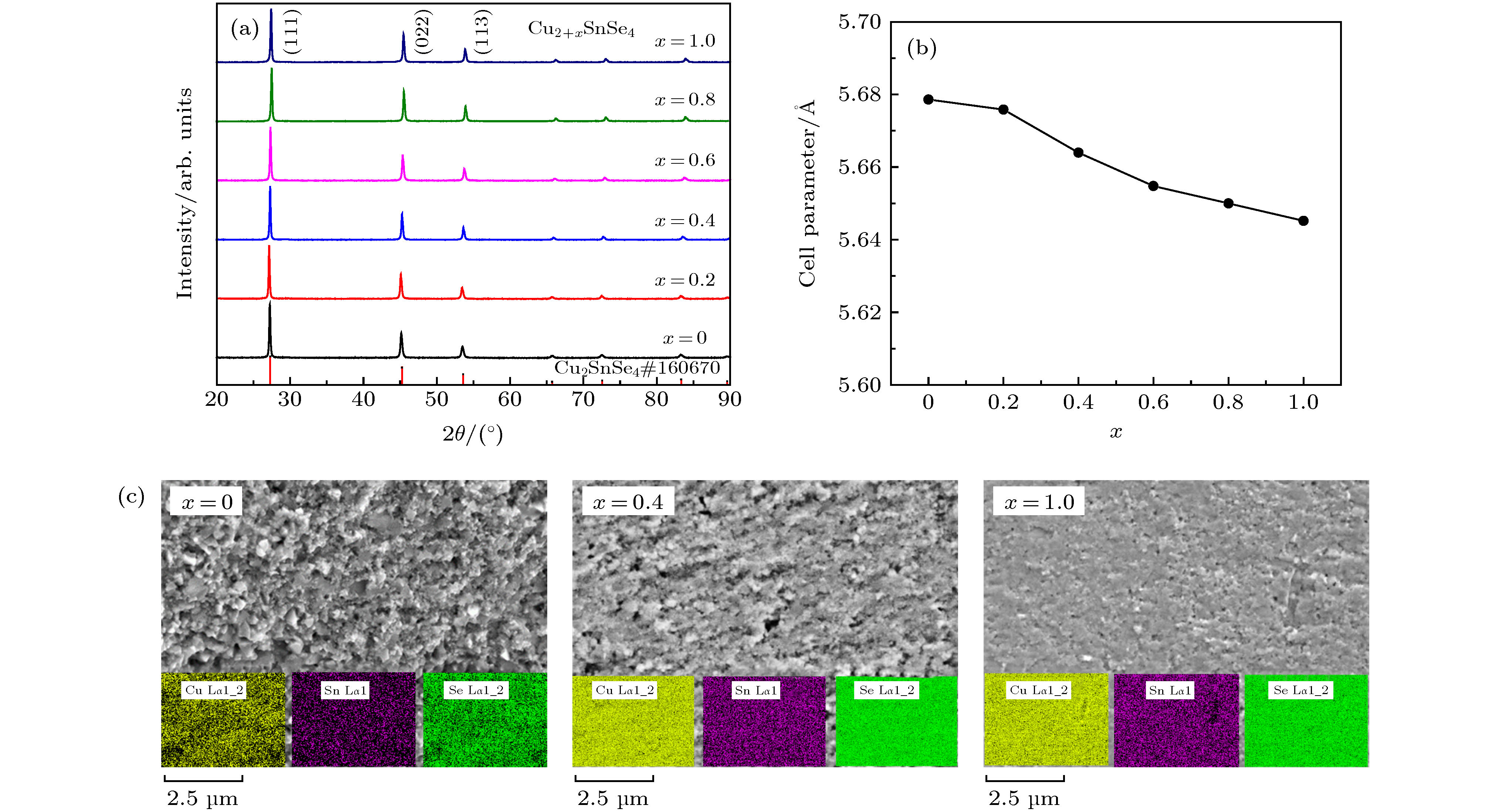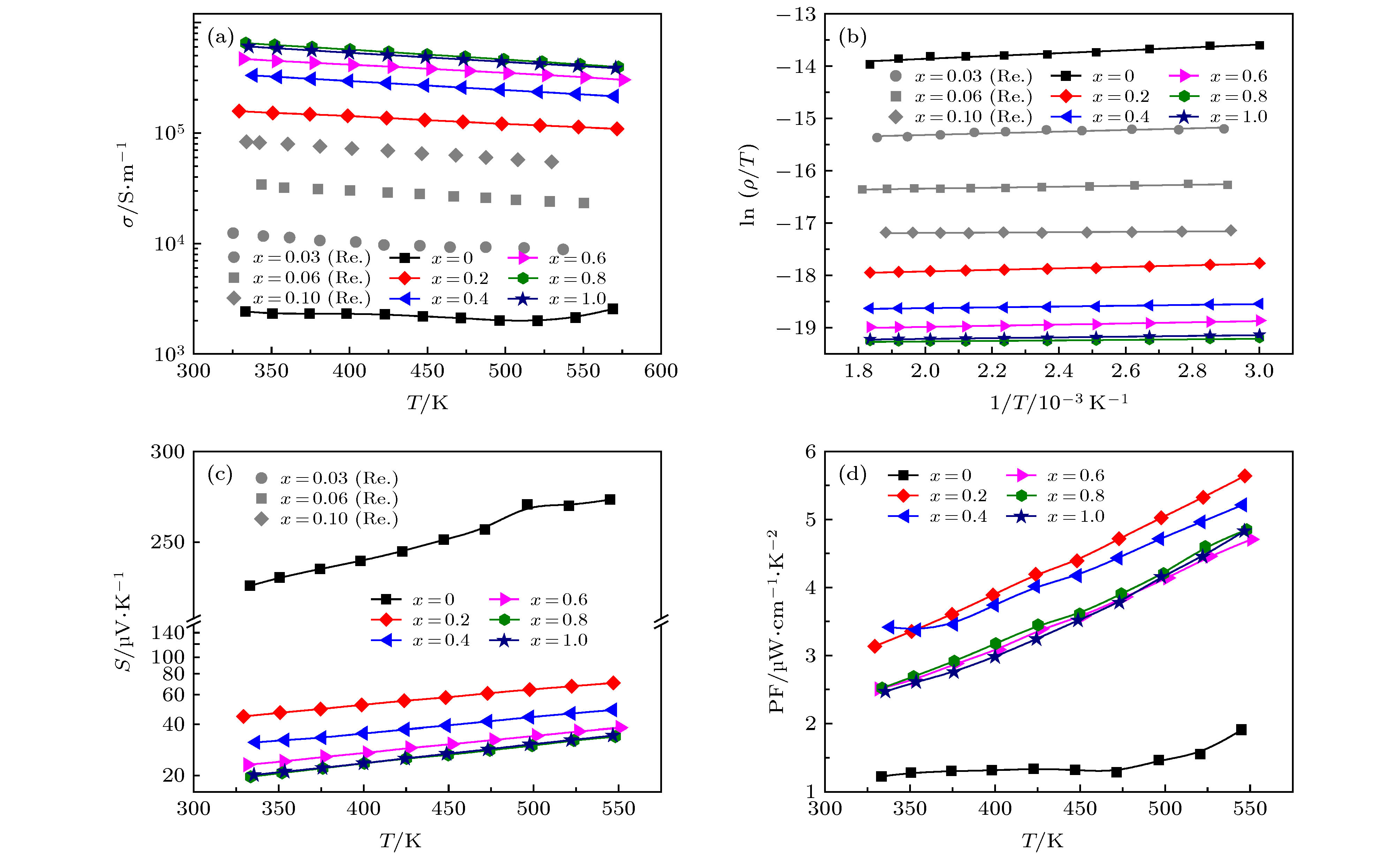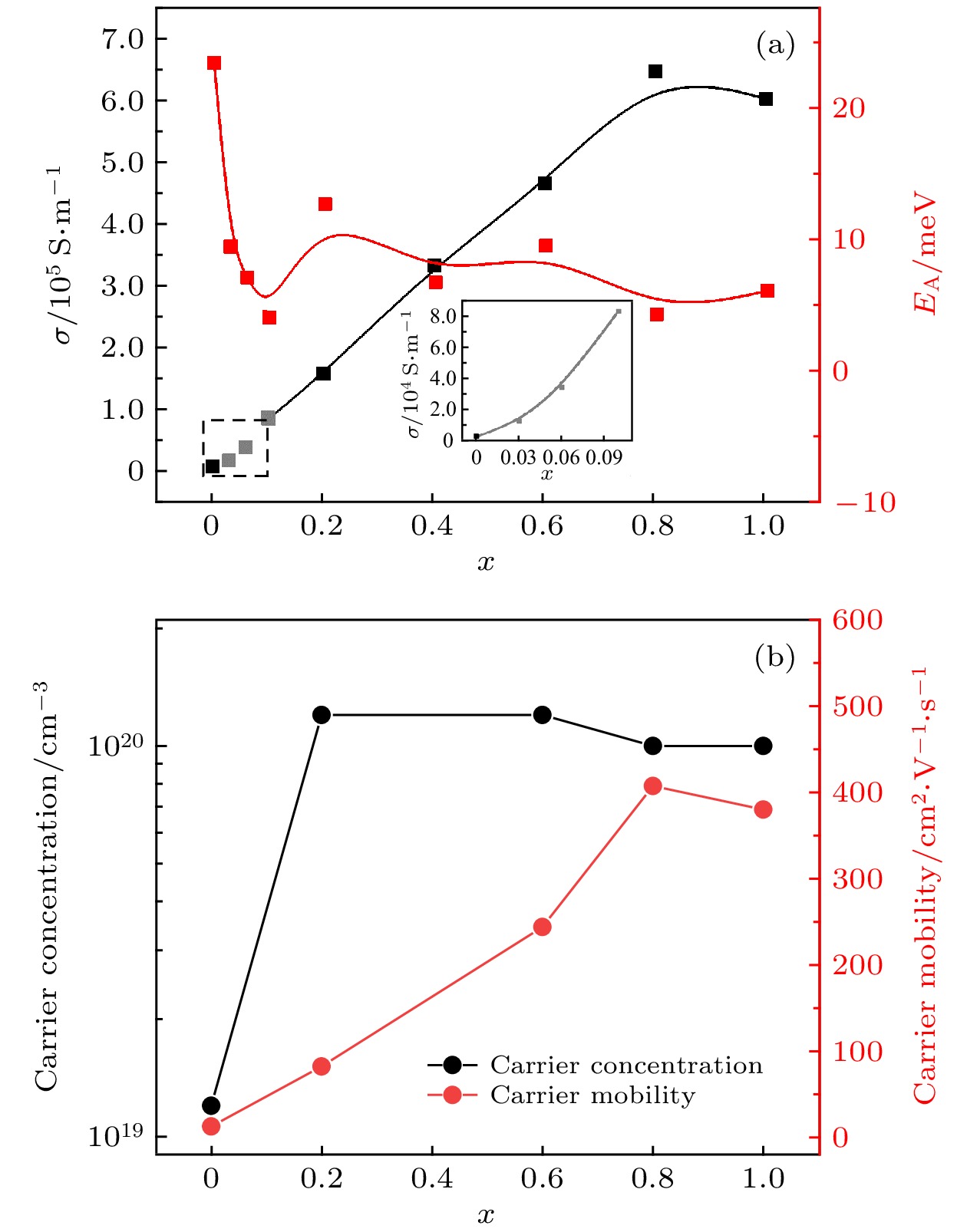-
Cu2SnSe4 compound, as a non-toxic inexpensive thermoelectric material, has low thermal conductivity and adjustable conductivity, which promises to have a high-efficiency thermoelectric application in a medium-temperature range. The Cu-doped bulk samples of Cu2+xSnSe4 (0 ≤ x ≤ 1) compounds are synthesized by a fast method, i.e. by combining high energy ball milling with spark plasma sintering. In this work, the thermoelectric properties of Cu-doped Cu2SnSe4 compound are investigated. The experimental results reveal that the intrinsic vacancy at Cu/Sn site of Cu2SnSe4 can be completely filled by Cu (i.e. x = 1 in Cu2+xSnSe4). The crystal structures of all Cu2+xSnSe4 samples have the same space group F3m as that of the undoped Cu2SnSe4. The electrical conductivity of Cu2+xSnSe4 increases rapidly with the content of Cu doped at intrinsic vacancy increasing, concretely, it increases by two orders of magnitude and reaches a maximum value at x = 0.8. The increase in electrical conductivity results in the significant improvement in power factor. The observed results display that the increase in electrical conductivity is a nonlinear relationship with Cu-doping content in a range of 0 < x < 0.1, but is linearly related to the Cu-doping content in a range of 0.1 ≤ x ≤ 0.8. Meanwhile, the carrier (hole) concentration is observed to reach a maximum value at x = 0.2 and then slightly decreases at x = 0.8. The rapid increase in electrical conductivity with Cu-doping content increasing may be attributed to the intensifying of Cu-Se bond network that plays a dominant role in controlling hole transport in Cu2SnSe4. The carrier mobility also increases with the Cu-doping content increasing in the range of 0 ≤ x ≤ 0.8, which is in contrast to the common scenarios in thermoelectric materials that the carrier mobility decreases with the increase in the carrier concentration. Furthermore, the carrier transport mechanism of Cu2+xSnSe4 sample is revealed to be able to be described by the small polaron hopping model, which means the strong coupling between electron and phonon. The analysis of thermal conductivities of the Cu2+xSnSe4 samples reveals that the relationship between the electronic thermal conductivity and the electrical conductivity cannot be described by the classical Wiedemanmn-Franz law, which may be attributed to the formation of electron-phonon coupled small polaron. Therefore, the coupling between electron and phonon inside the Cu2+xSnSe4 structure strongly influences the behaviors of carrier transmission and thermal conductivity.
-
Keywords:
- Cu2SnSe4 /
- thermoelectric properties /
- small-polaron transition
[1] DiSalvo F J 1999 Science 285 703
 Google Scholar
Google Scholar
[2] Dehkordi A M, Zebarjadi M, He J, Tritt T M 2015 Mater. Sci. Eng., R 97 1
 Google Scholar
Google Scholar
[3] Snyder G J, Toberer E S 2008 Nat. Mater. 7 105
 Google Scholar
Google Scholar
[4] Sussardi A, Tanaka T, Khan A U 2015 J. Materiomics 1 196
 Google Scholar
Google Scholar
[5] Gayner C, Kar K K 2016 Prog. Mater. Sci. 83 330
 Google Scholar
Google Scholar
[6] Rowe D M 2005 Thermoelectrics Handbook: Macro to Nano (1st Ed.) (Boca Raton: CRC press) Chaper 1 pp3−6
[7] Chasmar R P, Stratton R 1959 Int. J. Electron. 7 52
 Google Scholar
Google Scholar
[8] Rowe D M, Min G E 1998 J. Power Sources 73 193
 Google Scholar
Google Scholar
[9] Pan R, Yamei L, Jian H, et al. 2018 Inorg. Chem. Front. 5 2380
 Google Scholar
Google Scholar
[10] Hebert S, Berthebaud D, Daou R, et al. 2016 J. Phys. Condens. Matter 28 013001
 Google Scholar
Google Scholar
[11] Qiu P, Shi X, Chen L 2016 Energy Storage Mater. 3 85
 Google Scholar
Google Scholar
[12] Ma R, Liu G, Li Y, et al. 2018 J. Asian Ceram. Soc. 6 13
 Google Scholar
Google Scholar
[13] Ibanez M, Cadavid D, Anselmi-Tamburini U, et al. 2013 J. Mater. Chem. A 1 1421
 Google Scholar
Google Scholar
[14] Song J M, Liu Y, Niu H L, et al. 2013 J. Alloys Compd. 581 646
 Google Scholar
Google Scholar
[15] Fan J, Carrillo-Cabrera W, Akselrud L, et al. 2013 Inorg. Chem. 52 11067
 Google Scholar
Google Scholar
[16] Janicek P, Kucek V, Kasparova J, et al. 2019 J. Electron. Mater. 48 2112
 Google Scholar
Google Scholar
[17] Plirdpring T, Kurosaki K, Kosuga A, et al. 2012 Adv. Mater. 24 3622
 Google Scholar
Google Scholar
[18] Zhu Y C, Liu Y, Ren G K, et al. 2018 Inorg. Chem. 57 6051
 Google Scholar
Google Scholar
[19] Liu F S, Zheng J X, Huang M J, et al. 2014 Sci. Rep. 4 5774
 Google Scholar
Google Scholar
[20] Shi X Y, Xi L L, Fan J, et al. 2010 Chem. Mater. 22 6029
 Google Scholar
Google Scholar
[21] Li Y Y, Liu G H, Li J T, et al. 2016 New J. Chem. 40 5394
 Google Scholar
Google Scholar
[22] Fan J, Liu HL, Shi X Y, et al. 2013 Acta Mater. 61 4297
 Google Scholar
Google Scholar
[23] Lu X, Morelli D T, 2012 J. Electron. Mater. 41 1554
 Google Scholar
Google Scholar
[24] Raju C, Falmbigl M, Rogl P, et al. 2014 Mater. Chem. Phys. 147 1022
 Google Scholar
Google Scholar
[25] Prasad S K, Rao A, Gahtori B, et al. 2016 Mater. Res. Bull. 83 160
 Google Scholar
Google Scholar
[26] Li Y Y, Liu G H, Cao T F, et al. 2016 Adv. Funct. Mater. 26 6025
 Google Scholar
Google Scholar
[27] Marcano G, Rincón C, Marın G, et al. 2002 J. Appl. Phys. 92 1811
 Google Scholar
Google Scholar
[28] Wahab L A, El-Den M B, Farrag A A, et al. 2008 J. Phys. Chem. Solids 70 604
 Google Scholar
Google Scholar
[29] Baiyin M, Naren J, Gang G, et al. 2013 Inorg. Chem. Commun. 35 135
 Google Scholar
Google Scholar
[30] Li W, Lin S, Zhang X, et al. 2016 Chem. Mater. 28 6227
 Google Scholar
Google Scholar
[31] 范宝新, 聂玉昕, 杨国桢 2009 中国大百科全书·物理学 (第二版) (北京: 中国大百科全书出版社) 第759页
Fan B X, Nie Y X, Yang G Z 2009 Chinese Encyclopedia: Physics (2nd Ed.) (Beijing: Encyclopedia of China Publishing House) p759 (in Chinese)
[32] Lee S K, Yang H F, Hong J, et al. 2017 Science 355 371
 Google Scholar
Google Scholar
-
图 3 样品Cu2+xSnSe4 (x = 0, 0.2, 0.4, 0.6, 0.8, 1)的(a) 电导率、(b) 小极化子模型拟合、(c) Seebeck系数和(d) 功率因子, 其中Re.代表文献[30]结果
Figure 3. Temperature dependence of (a) electrical conductivity, (b) the small polaron hopping model fitting, (c) Seebeck coefficient and (d) power factor (PF) for the samples of Cu2+xSnSe4 (x = 0, 0.2, 0.4, 0.6, 0.8, 1). Re. represents the results of Ref [30]
图 4 (a) Cu2+xSnSe4 (x = 0, 0.03[30], 0.06[30], 0.1[30], 0.2, 0.4, 0.6, 0.8, 1)在323 K的电导率和极化子激活能 (插图为标记处放大图); (b) Cu2+xSnSe4部分样品的室温载流子浓度和迁移率
Figure 4. (a) Electrical conductivity and activation energy for the sample of Cu2+xSnSe4 (x = 0, 0.03[30], 0.06[30], 0.1[30], 0.2, 0.4, 0.6, 0.8, 1) at 323 K; (b) carrier concentration and carrier mobility of Cu2+xSnSe4 at room temperature.
-
[1] DiSalvo F J 1999 Science 285 703
 Google Scholar
Google Scholar
[2] Dehkordi A M, Zebarjadi M, He J, Tritt T M 2015 Mater. Sci. Eng., R 97 1
 Google Scholar
Google Scholar
[3] Snyder G J, Toberer E S 2008 Nat. Mater. 7 105
 Google Scholar
Google Scholar
[4] Sussardi A, Tanaka T, Khan A U 2015 J. Materiomics 1 196
 Google Scholar
Google Scholar
[5] Gayner C, Kar K K 2016 Prog. Mater. Sci. 83 330
 Google Scholar
Google Scholar
[6] Rowe D M 2005 Thermoelectrics Handbook: Macro to Nano (1st Ed.) (Boca Raton: CRC press) Chaper 1 pp3−6
[7] Chasmar R P, Stratton R 1959 Int. J. Electron. 7 52
 Google Scholar
Google Scholar
[8] Rowe D M, Min G E 1998 J. Power Sources 73 193
 Google Scholar
Google Scholar
[9] Pan R, Yamei L, Jian H, et al. 2018 Inorg. Chem. Front. 5 2380
 Google Scholar
Google Scholar
[10] Hebert S, Berthebaud D, Daou R, et al. 2016 J. Phys. Condens. Matter 28 013001
 Google Scholar
Google Scholar
[11] Qiu P, Shi X, Chen L 2016 Energy Storage Mater. 3 85
 Google Scholar
Google Scholar
[12] Ma R, Liu G, Li Y, et al. 2018 J. Asian Ceram. Soc. 6 13
 Google Scholar
Google Scholar
[13] Ibanez M, Cadavid D, Anselmi-Tamburini U, et al. 2013 J. Mater. Chem. A 1 1421
 Google Scholar
Google Scholar
[14] Song J M, Liu Y, Niu H L, et al. 2013 J. Alloys Compd. 581 646
 Google Scholar
Google Scholar
[15] Fan J, Carrillo-Cabrera W, Akselrud L, et al. 2013 Inorg. Chem. 52 11067
 Google Scholar
Google Scholar
[16] Janicek P, Kucek V, Kasparova J, et al. 2019 J. Electron. Mater. 48 2112
 Google Scholar
Google Scholar
[17] Plirdpring T, Kurosaki K, Kosuga A, et al. 2012 Adv. Mater. 24 3622
 Google Scholar
Google Scholar
[18] Zhu Y C, Liu Y, Ren G K, et al. 2018 Inorg. Chem. 57 6051
 Google Scholar
Google Scholar
[19] Liu F S, Zheng J X, Huang M J, et al. 2014 Sci. Rep. 4 5774
 Google Scholar
Google Scholar
[20] Shi X Y, Xi L L, Fan J, et al. 2010 Chem. Mater. 22 6029
 Google Scholar
Google Scholar
[21] Li Y Y, Liu G H, Li J T, et al. 2016 New J. Chem. 40 5394
 Google Scholar
Google Scholar
[22] Fan J, Liu HL, Shi X Y, et al. 2013 Acta Mater. 61 4297
 Google Scholar
Google Scholar
[23] Lu X, Morelli D T, 2012 J. Electron. Mater. 41 1554
 Google Scholar
Google Scholar
[24] Raju C, Falmbigl M, Rogl P, et al. 2014 Mater. Chem. Phys. 147 1022
 Google Scholar
Google Scholar
[25] Prasad S K, Rao A, Gahtori B, et al. 2016 Mater. Res. Bull. 83 160
 Google Scholar
Google Scholar
[26] Li Y Y, Liu G H, Cao T F, et al. 2016 Adv. Funct. Mater. 26 6025
 Google Scholar
Google Scholar
[27] Marcano G, Rincón C, Marın G, et al. 2002 J. Appl. Phys. 92 1811
 Google Scholar
Google Scholar
[28] Wahab L A, El-Den M B, Farrag A A, et al. 2008 J. Phys. Chem. Solids 70 604
 Google Scholar
Google Scholar
[29] Baiyin M, Naren J, Gang G, et al. 2013 Inorg. Chem. Commun. 35 135
 Google Scholar
Google Scholar
[30] Li W, Lin S, Zhang X, et al. 2016 Chem. Mater. 28 6227
 Google Scholar
Google Scholar
[31] 范宝新, 聂玉昕, 杨国桢 2009 中国大百科全书·物理学 (第二版) (北京: 中国大百科全书出版社) 第759页
Fan B X, Nie Y X, Yang G Z 2009 Chinese Encyclopedia: Physics (2nd Ed.) (Beijing: Encyclopedia of China Publishing House) p759 (in Chinese)
[32] Lee S K, Yang H F, Hong J, et al. 2017 Science 355 371
 Google Scholar
Google Scholar
Catalog
Metrics
- Abstract views: 9196
- PDF Downloads: 169
- Cited By: 0















 DownLoad:
DownLoad:





